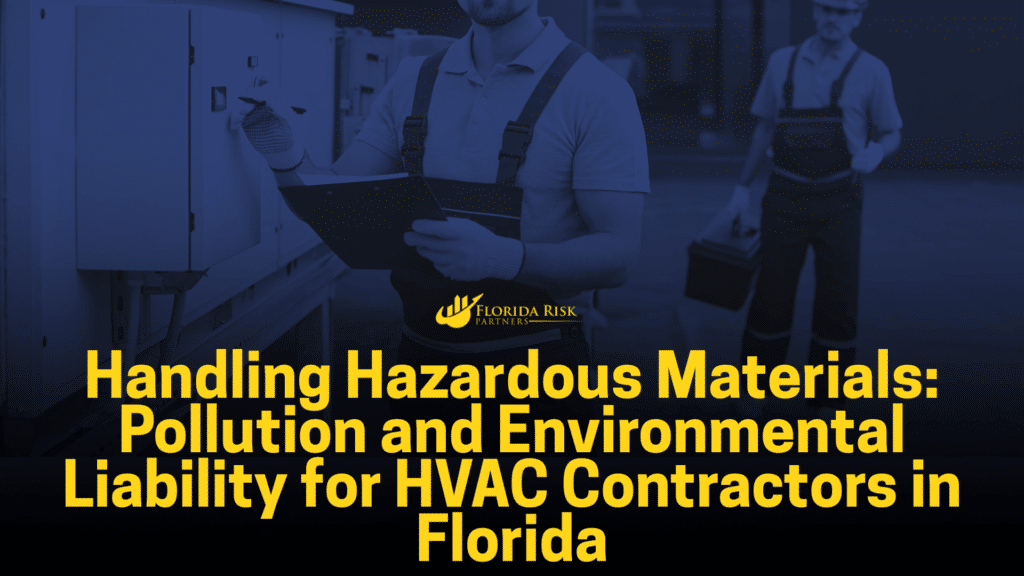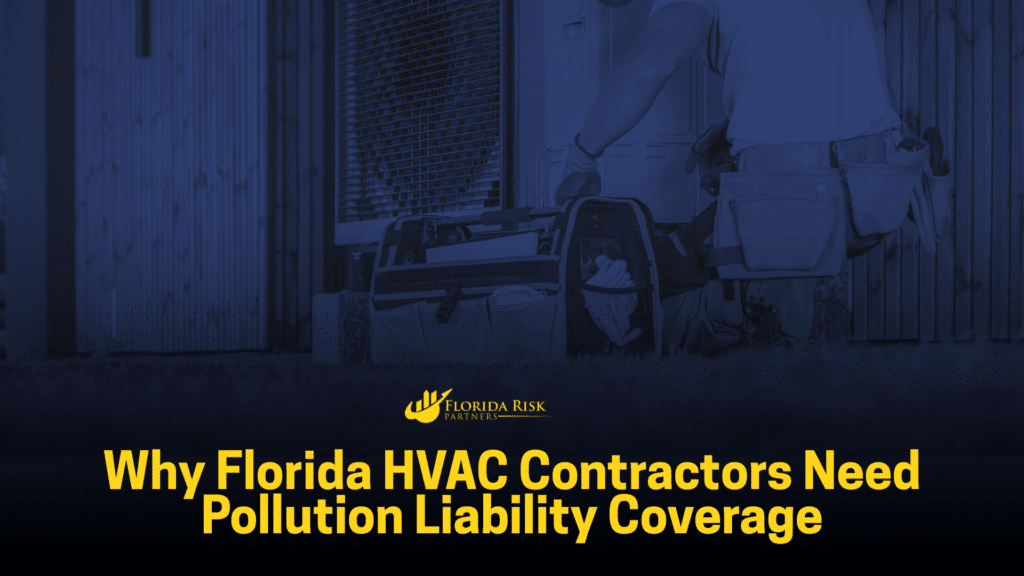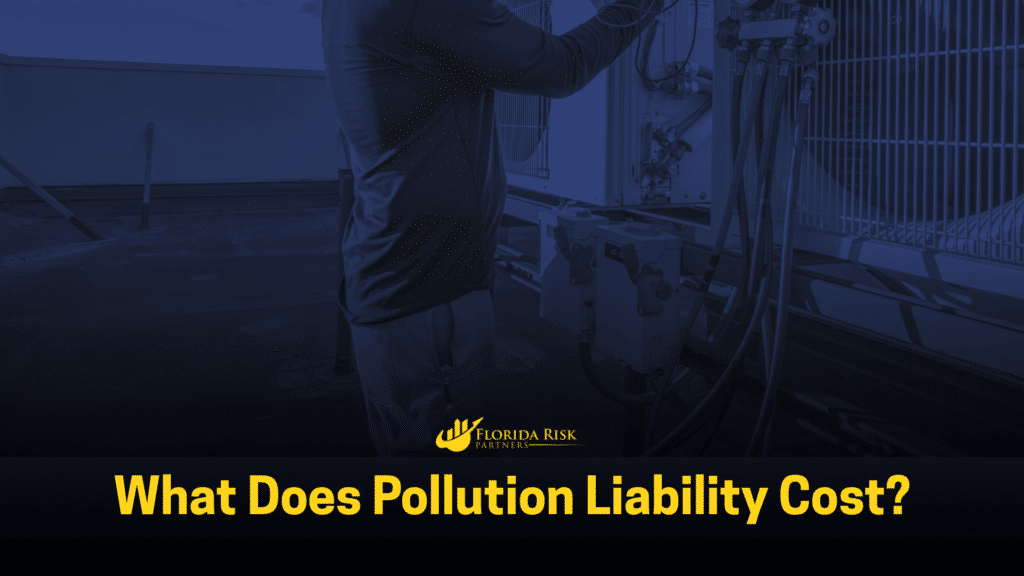-
Main Office: 1434 E. Bloomingdale Ave Valrico, FL 33596-6110
-
Phone: (888) 601-6660
-
Email: info@floridariskpartners.com

When most HVAC contractors think of insurance risks, they picture physical injuries, property damage, or vehicle accidents. But there’s another high-stakes exposure flying under the radar: pollution and environmental liability.
Whether it’s a refrigerant leak, mold growth, or improper equipment disposal, HVAC contractors in Florida face a growing number of situations where a standard general liability policy simply won’t provide coverage. That’s because most general liability policies exclude pollution-related claims—leaving your business vulnerable to expensive lawsuits, environmental cleanup costs, and even regulatory fines.
This week, we’ll explore what pollution liability is, why it matters to HVAC contractors in Florida, what typical claims look like, and how to protect your business before a claim puts you in hot water.
What Is Pollution Liability Insurance?
Pollution liability insurance—also known as Contractors Pollution Liability (CPL)—is a specialized policy that covers claims related to:
- The release, discharge, or escape of pollutants
- Contamination of air, water, or soil
- Health hazards to people caused by poor indoor air quality or chemical exposure
- Cleanup and remediation costs
- Legal defense from lawsuits or regulatory action
This coverage fills a critical gap left by your general liability policy, which often excludes coverage for mold, refrigerants, and environmental hazards—even if you didn’t intentionally cause the problem.
Why Florida HVAC Contractors Need Pollution Liability Coverage
Florida is a unique—and challenging—state for HVAC businesses. The combination of extreme humidity, strict building codes, and growing environmental regulations makes pollution-related exposures far more likely.
1. Mold Growth Is a Major Liability
Mold thrives in Florida’s climate and often becomes an issue when HVAC systems fail to dehumidify properly, ductwork leaks, or units aren’t sized correctly. If mold appears after a system installation, you can be accused of contributing to it—even if you followed protocol.
General liability won’t cover mold-related bodily injury or property damage unless a specific endorsement is added.
2. Refrigerant Leaks Can Trigger Environmental Claims

Modern refrigerants are tightly regulated. If a technician accidentally releases refrigerant during a service call, your company could be responsible for:
- Health issues to occupants
- Property damage
- Cleanup expenses
- EPA or state regulatory fines
These situations fall squarely under pollution liability.
3. Improper Disposal of Old Equipment
Removing old systems means dealing with components that may contain hazardous materials—like oils, refrigerants, and insulation. If these aren’t disposed of properly and something leaks, your company could be named in an environmental lawsuit or investigation.
What Does Pollution Liability Cover?
Pollution liability insurance typically includes:
✔ Third-party bodily injury and property damage caused by pollutants
✔ Mold-related claims involving health issues or cleanup costs
✔ Refrigerant spills and chemical discharge during service or installation
✔ Costs to investigate, remediate, and clean up contamination
✔ Legal defense and settlement costs
✔ Coverage for work performed by subcontractors, if structured properly
What It Doesn’t Cover
✘ Intentional or criminal acts (e.g., illegal dumping)
✘ Known pollution conditions before policy inception
✘ Non-pollution property damage (that’s still general liability)
✘ Employee injuries (covered under workers’ compensation)
Real-World Scenarios in Florida: Pollution Liability in Action
Let’s look at some common (and costly) pollution-related claims that HVAC contractors in Florida face:
Scenario 1: Mold in a Tampa Townhome
An HVAC contractor installed a new air handler in a second-floor closet. Improper sealing caused moisture buildup behind the wall, eventually leading to a serious mold outbreak. The homeowner developed respiratory issues and sued. The contractor’s general liability policy excluded mold, but the pollution policy covered medical costs, cleanup, and legal defense—over $85,000 in total.
Scenario 2: Refrigerant Leak in a Fort Myers Retail Space
A technician accidentally released refrigerant while repairing a commercial rooftop unit. The chemical leaked into the air ducts and affected several adjacent retail tenants. EPA reporting was triggered, and a cleanup crew was required. The pollution liability policy covered $60,000 in remediation and regulatory compliance costs.
Scenario 3: Improper Disposal of Units in Orlando
After replacing 10 split systems, an HVAC crew left the old equipment at a construction site, where refrigerant oil leaked into the soil. A contractor reported it to the Florida Department of Environmental Protection. The HVAC company was cited and fined, but the pollution policy covered the cleanup and helped negotiate the fine.
What Does Pollution Liability Cost?

Pollution liability coverage is more affordable than most contractors expect. Pricing depends on:
- The scope of services you provide
- Annual revenue and number of technicians
- Type of work (residential vs. commercial, new construction vs. service)
- Prior claims history
Most small to mid-sized Florida HVAC contractors pay $750 to $2,500 per year for standalone pollution liability coverage. Some insurers offer pollution endorsements on your general liability policy—but these usually provide limited protection and should be reviewed carefully.
Risk Management Tips to Avoid Pollution Claims
In addition to insurance, here’s how to reduce your pollution liability risk on every job:
1. Train Techs on Refrigerant Handling
- Follow EPA Section 608 requirements for refrigerant recovery
- Label all cylinders clearly
- Use certified recovery equipment
2. Focus on Moisture and Mold Prevention
- Seal ductwork carefully
- Ensure proper drainage from condensate lines
- Use dehumidifiers or fresh air systems in high-moisture environments
3. Document System Performance and Maintenance
- Keep detailed installation and service records
- Use signed checklists for airflow, pressure testing, and humidity checks
- Take photos of completed jobs for future defense
4. Vet Your Subcontractors
If you subcontract part of your work, ensure they carry their own pollution liability coverage, or confirm your policy extends to them.
Final Thoughts: Protect Your Business from the Claims You Didn’t See Coming
Pollution and environmental liability aren’t just problems for big corporations or industrial sites. In the HVAC world, one misplaced drain line or refrigerant hose can become a lawsuit—or a regulatory nightmare.
In Florida, where mold, moisture, and environmental sensitivity are always part of the equation, pollution liability coverage is a must-have for HVAC contractors who want to protect their business, their team, and their future.
Call Us Or
Schedule an Appointment
Select an agent below to view our online calendars and select a day and time that works best for you or call us directly at 888-601-6660. When you use our online calendars, you will receive an email with more information.



